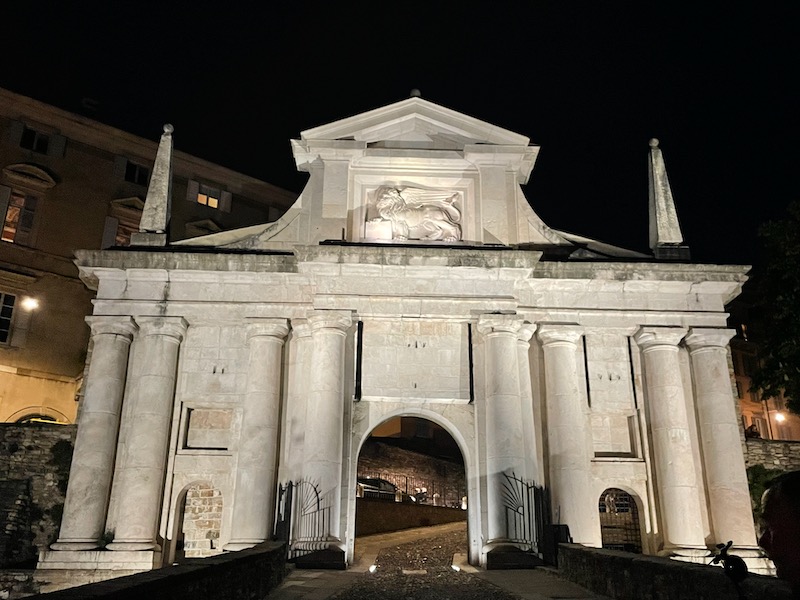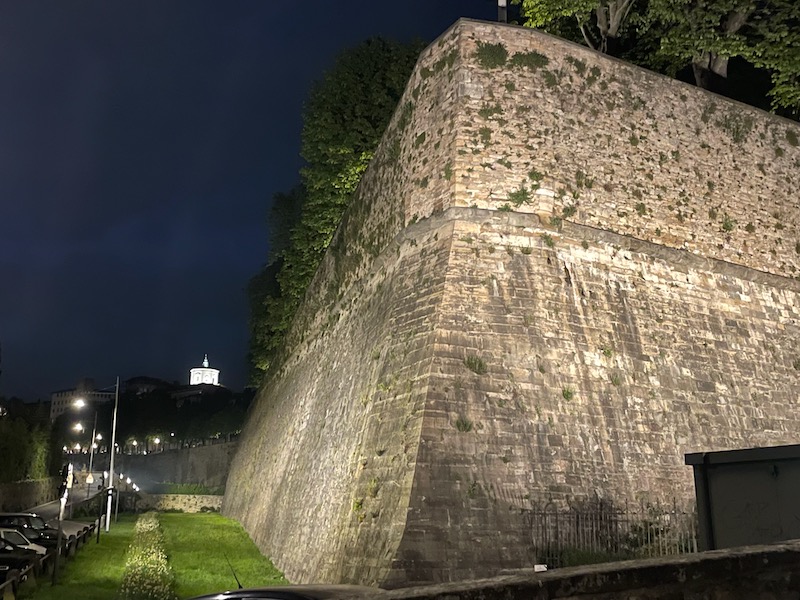Our Blog - Lombardy 2025 - Bergamo, Italy
We have made it to the part of the Lombardy region that is considered part of the Alps. The city of Bergamo is composed of an old walled city, known as Città Alta ('Upper Town'), nestled in the hills and enclosed with Venetian defensive walls, and a modern section in the plains below. Our "touristy" time was spent in the Upper Town but our hotel was in the lower, modern town. While it would have been cool to stay up there, driving and parking was much easier at the bottom.
Supposedly, Farmacia Guidetti has roots going back to the medieval period, playing a significant role in the development of pharmacy as a profession. The pharmacy's origins can be traced to the ancient practice of medicine and pharmacy in monastic settings, where monks and nuns served as both doctors and pharmacists. I just thought the carved sign was nice.
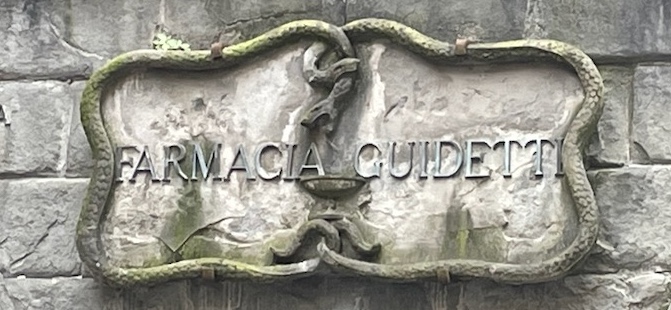
The 4 gates along the walls are named after the churches that were once located nearby (only 1 church remains, the other 3 were demolished in 1561 to build the walls). Porta di San Giacomo was completed in 1593 and has a carving of the winged lion of Saint Mark, the symbol of Venice, at the top. You can also see the stone bridge leading to the gate, which was built in 1780. And then some pictures of the lower (modern) town, the walls, and the stone bridge.
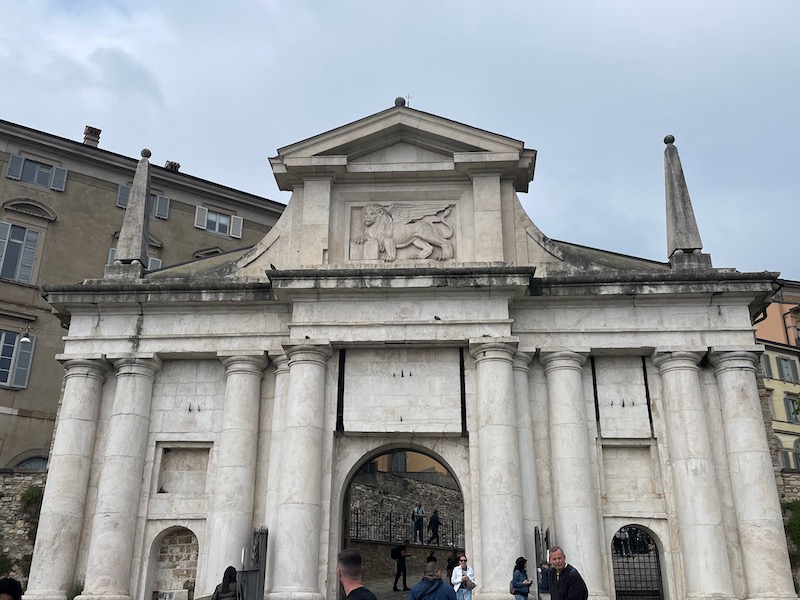
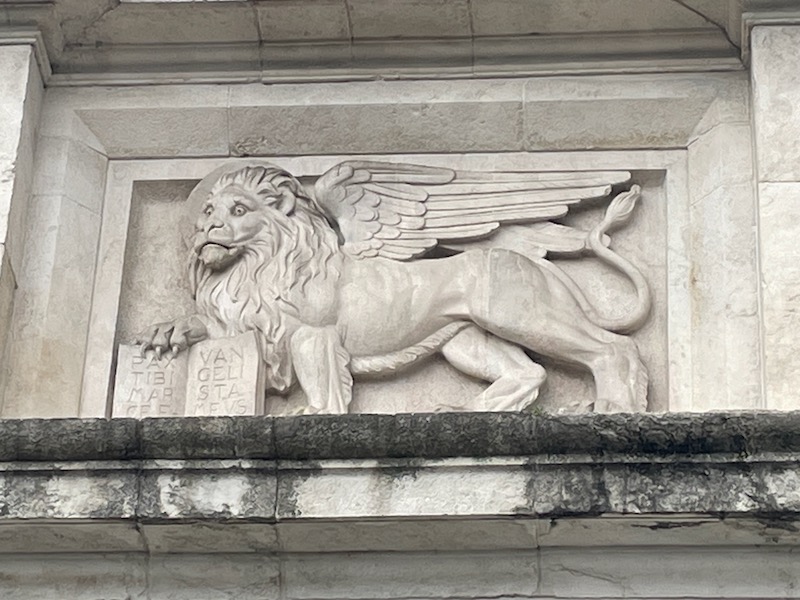
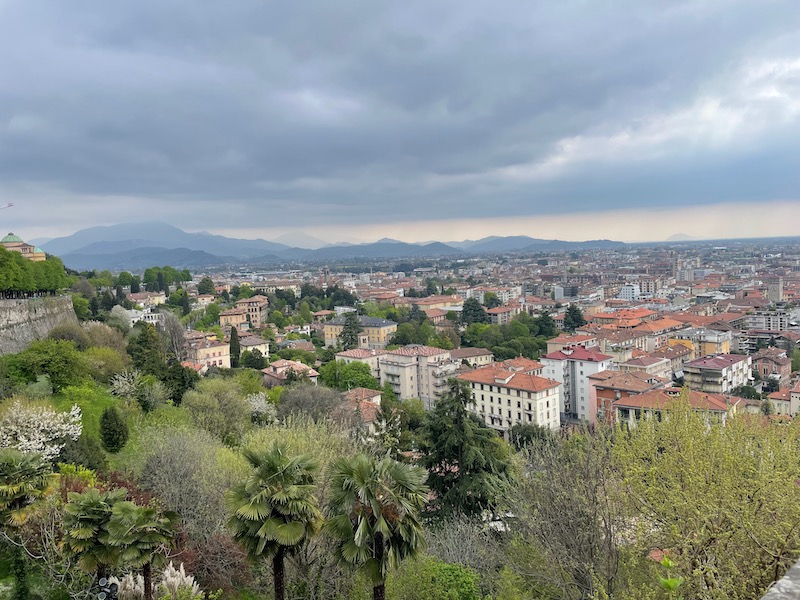
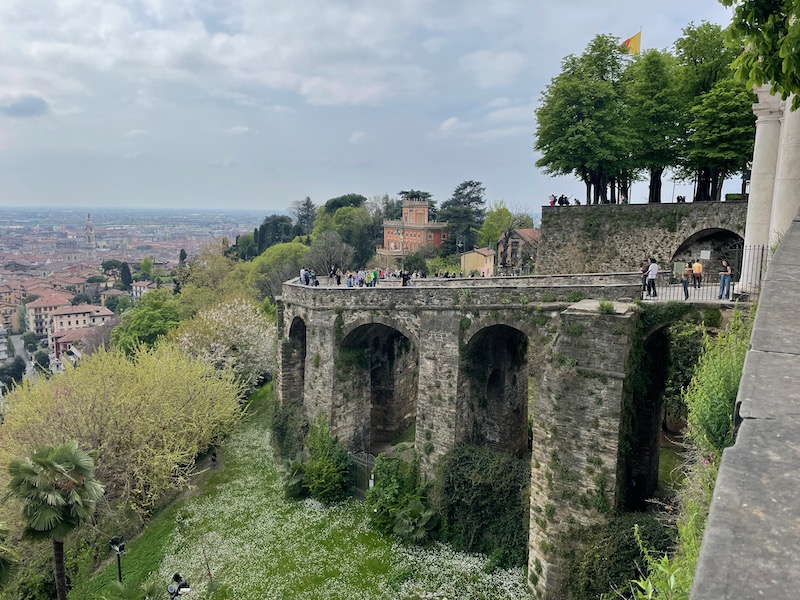
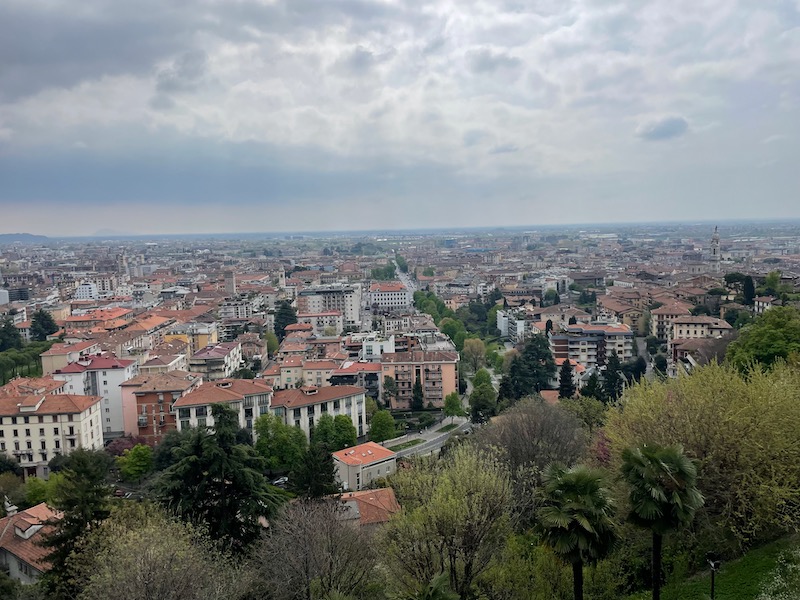
We always try to eat "local" or "regional" dishes when we travel, and today's lunch was no different ... it was a "street food" polenta place. First was polenta (which you can't see) covered with local Bergamo salami, and a polenta with a gorgonzola sauce.
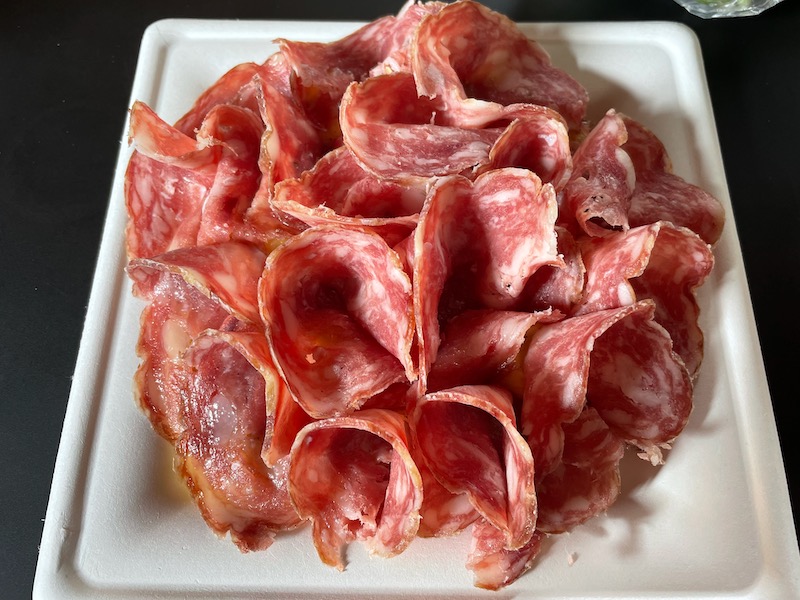

It is difficult to see the majority of the Torre del Gombito, which is located at the most central and important crossroads of the ancient city. The tower takes its name from the Latin compitum, which means crossroads, and it is the tallest tower in the city. It was originally built in the 12th century but set on fire and rebuilt in 1263. In 1314, the owners belonged to the Guelph faction (those that supported the Pope instead of the Holy Roman Emperor) and had to flee the city. The tower was donated to the municipality in 1877 and since 2010, it has been open to the public for a visit inside. After climbing 263 steps you can enjoy the view from the highest terrace in Bergamo.
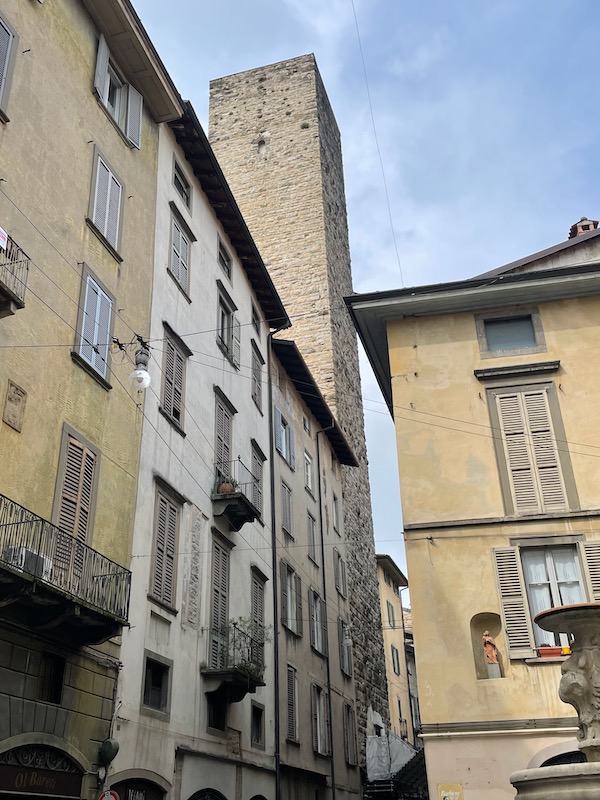
Piazza Vecchia is the main square in the historical town and it is located on the old Roman forum. It is surrounded by historical buildings and the Contarini Fountain stands in the middle. The fountain is surrounded by lions, and here is Lucy trying to look noble, like the lion behind.
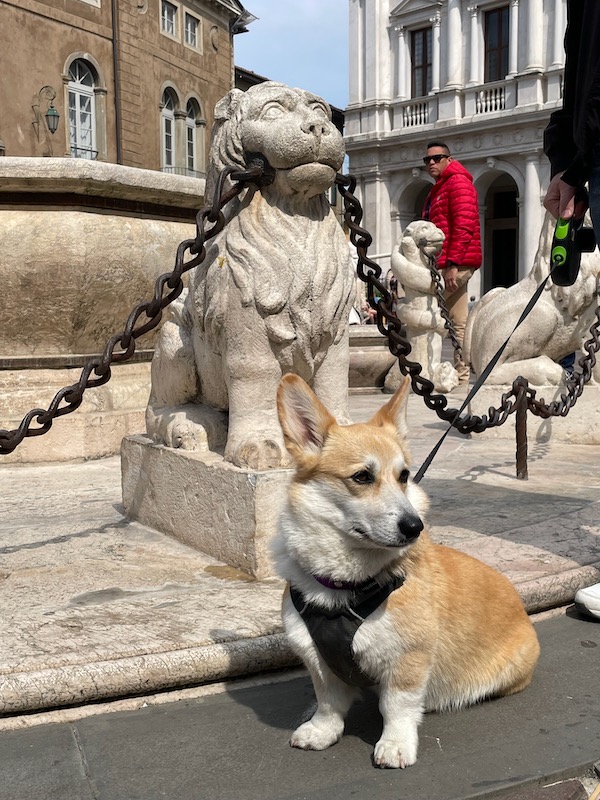
Several cities have a "Palazzo della Ragione" or Palace of Reason, which normally had a judicial purpose in the Middle Ages. Here you can see the building on the left side, with a staircase and bell tower (on the right). The area was originally occupied by houses that were demolished to rebuild this square in the 12th century. Very similar to other Italian municipal buildings built in the Middle Ages, it has a ground floor open on three sides with a portico.
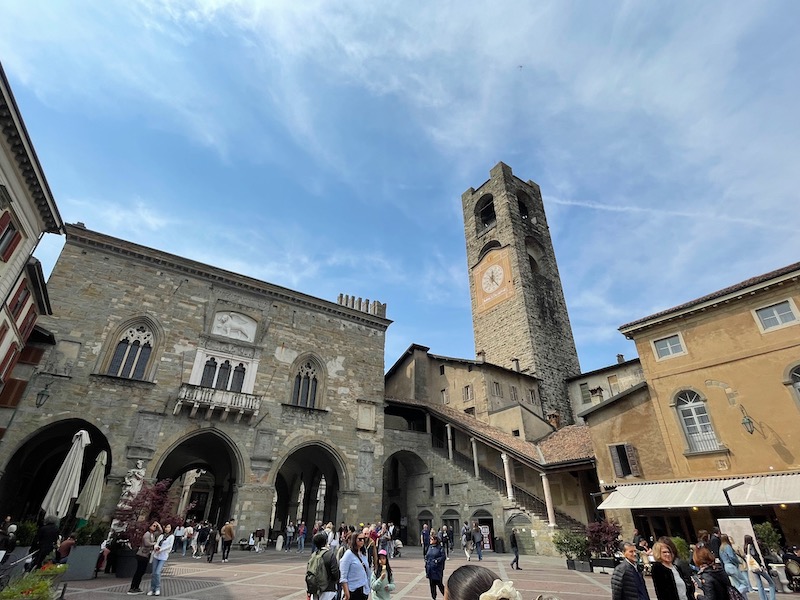
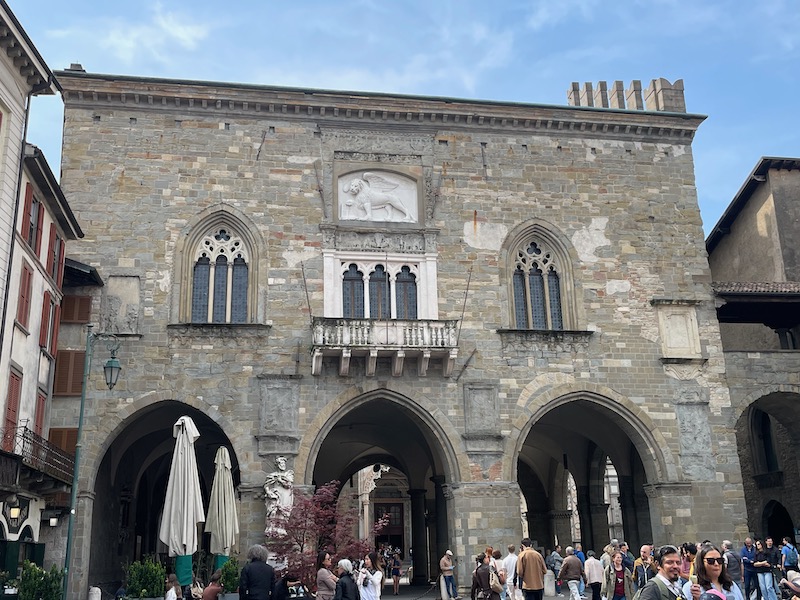
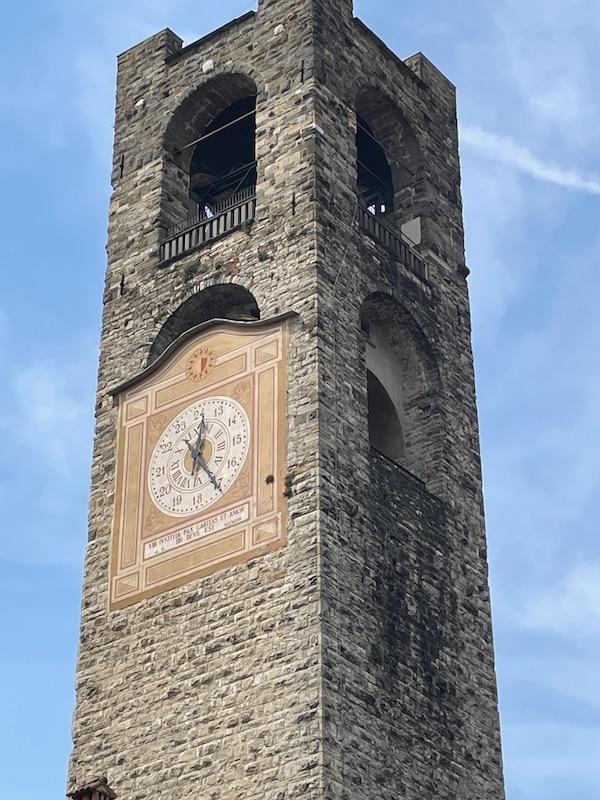
On the other side of the square from the Palace of Reason is the Palazzo Nuovo. It was built in the early 17th century and was initially intended to house the city government. The white marble facade was added in 1928.
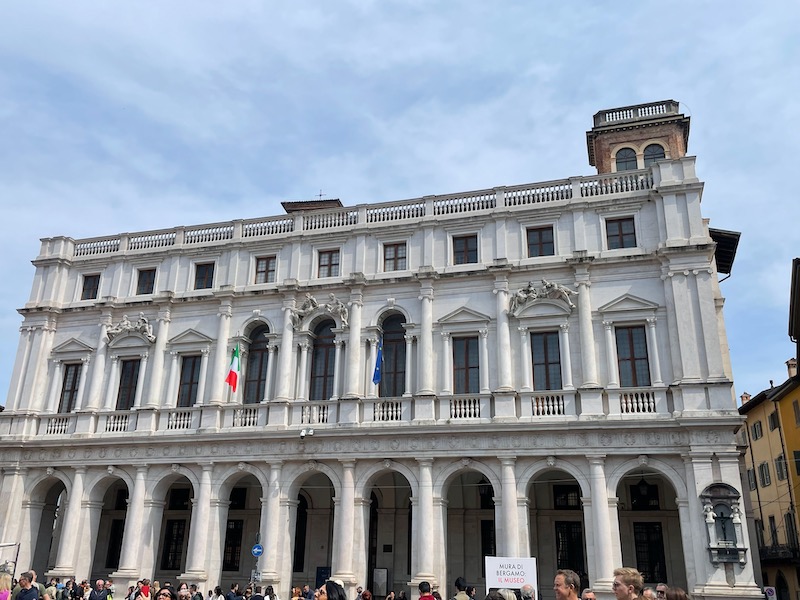
The Basilica di Santa Maria Maggiore was built in the 2nd half of the 12th century and 2 Gothic porches were added in 1351. You can clearly see the difference in style from the quite basic stone main church, the 3-story porch Gothic porch (there is another porch like this on the back-side of the church), and then the over-the-top decoration of the Colleoni Chapel (more info on this chapel later). This Gothic porch is called the Red Lions Gate due to the 2 red lions that hold up the columns on the top stair. The first level of statues has 2 saints around an equestrian statue of Saint Alexander, and at the top, Madonna and Child flanked by Saint Esteria and Saint Grata.
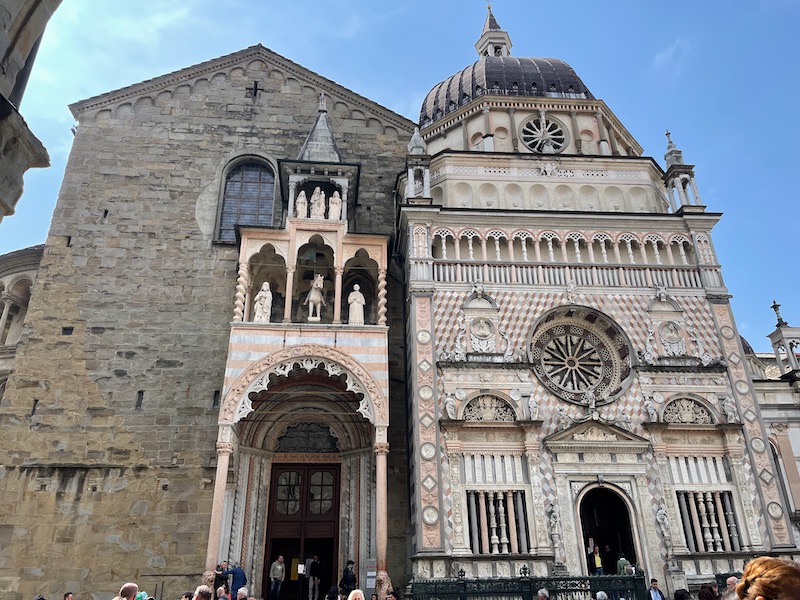
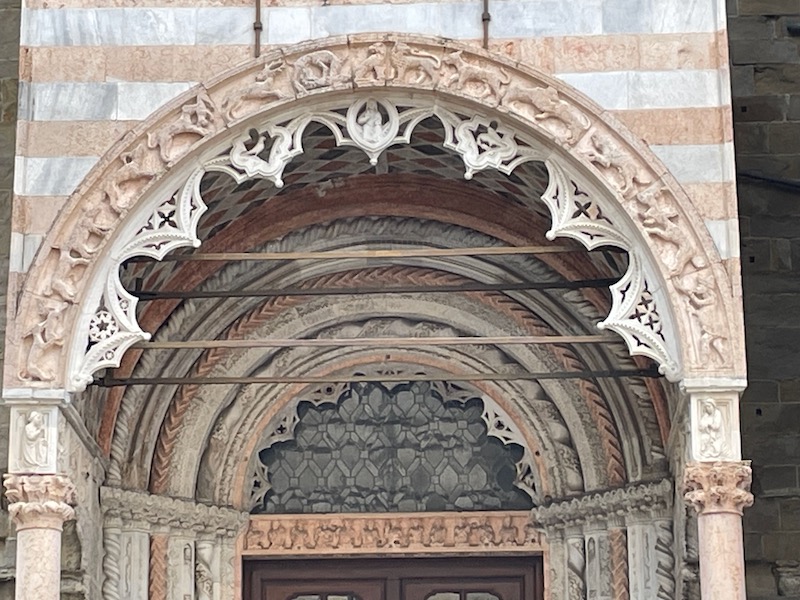
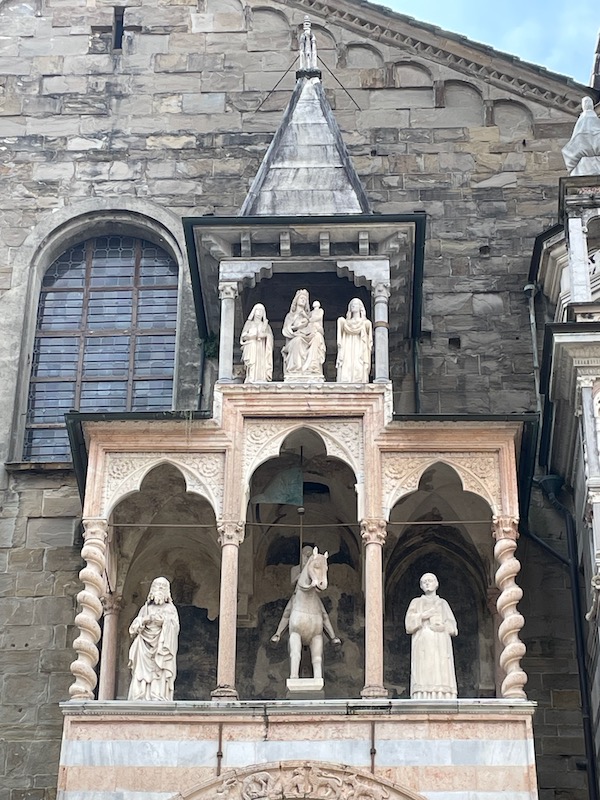
The interior of the Basilica retains the Romanesque Greek cross plan with three naves divided by pillars ending in the apse, but the decoration was carried out in the 17th century. Along the walls and on the pillars are hung 16th and 17th century tapestries. The ceiling and the decorative elements is hard to capture in picture (sorry, guess you'll need to take a trip to Bergamo). There are LOTS of tapestries hanging here, more than really any other church that I remember. In fact, there are 25 tapestries of various sizes, with both religious and non-religious scenes.
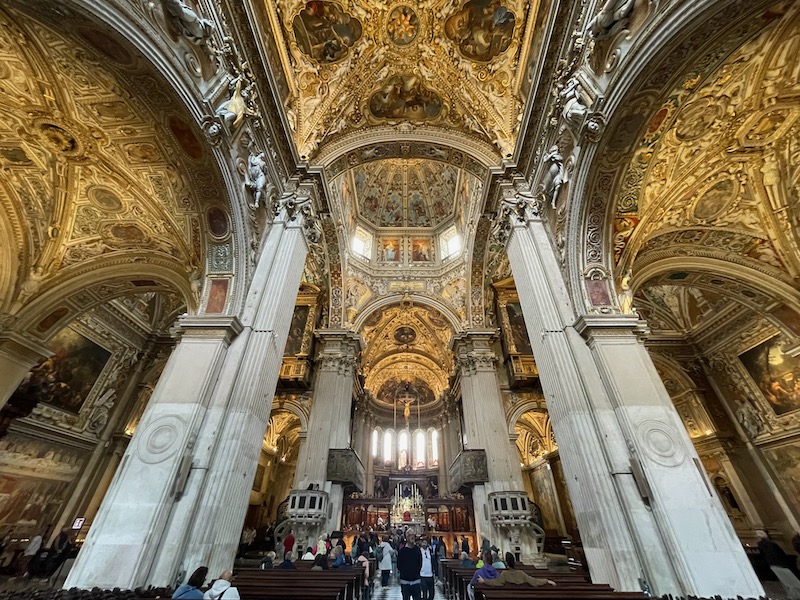
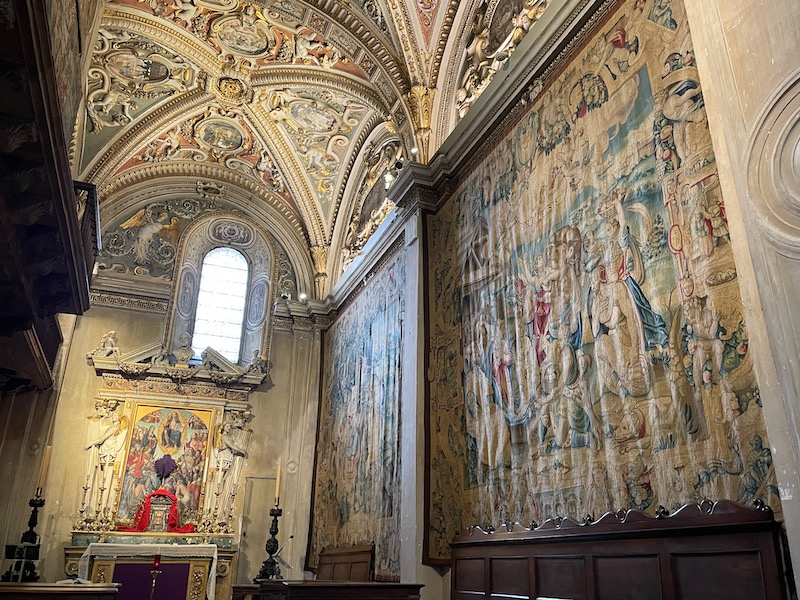
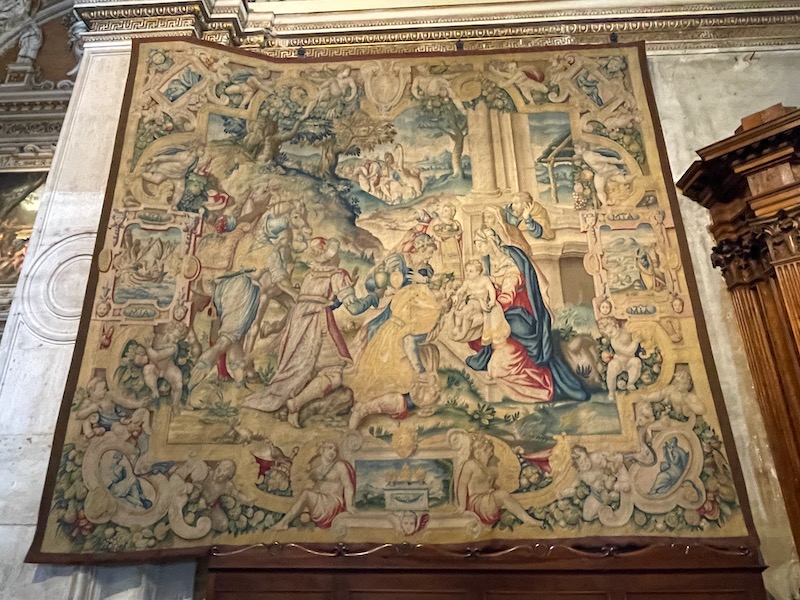
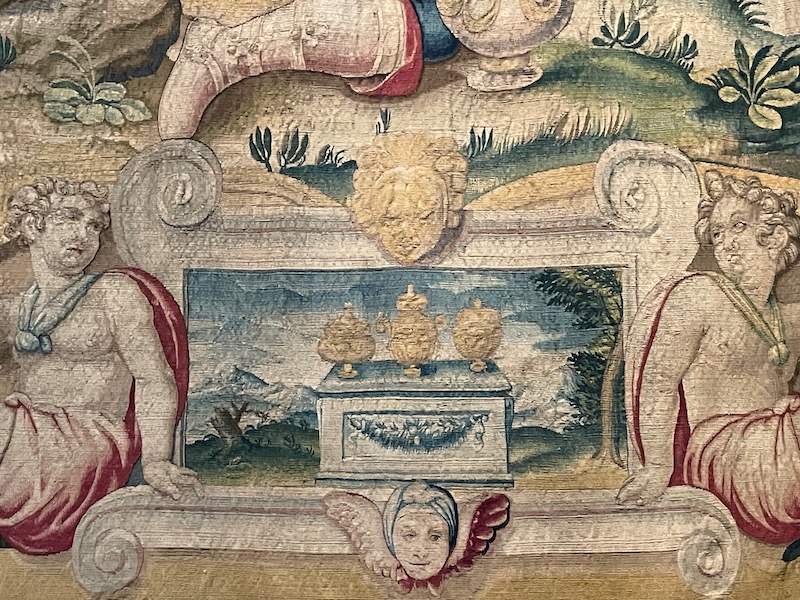
This is a tapestry representing the Crucifixion, created in Antwerp in 1698.
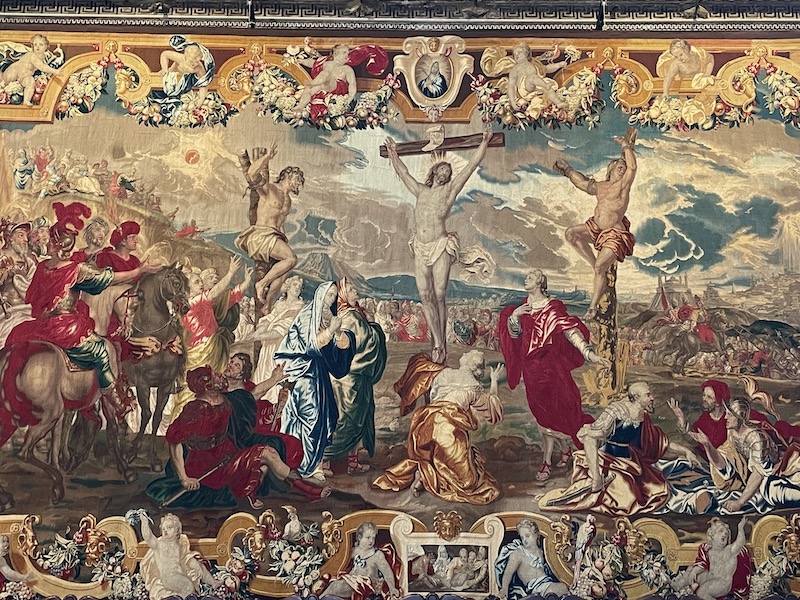
At the beginning of the 16th century, the church was still in Gothic style without the elaborate stucco and marble decorations that were added in the 17th century. They felt that the main altar was not "suitable" for the new Basilica and so changes were made, including adding a wooden choir to the presbytery. These wooden inlay panels were done between 1522 and 1533, and were meant to help the faithful towards greater spiritual and intellectual reflection. The first detail panel I show depicts Noah's Arc, done in 1525, and the 2nd is the Submergence of the Pharaoh, done in 1526-1527.
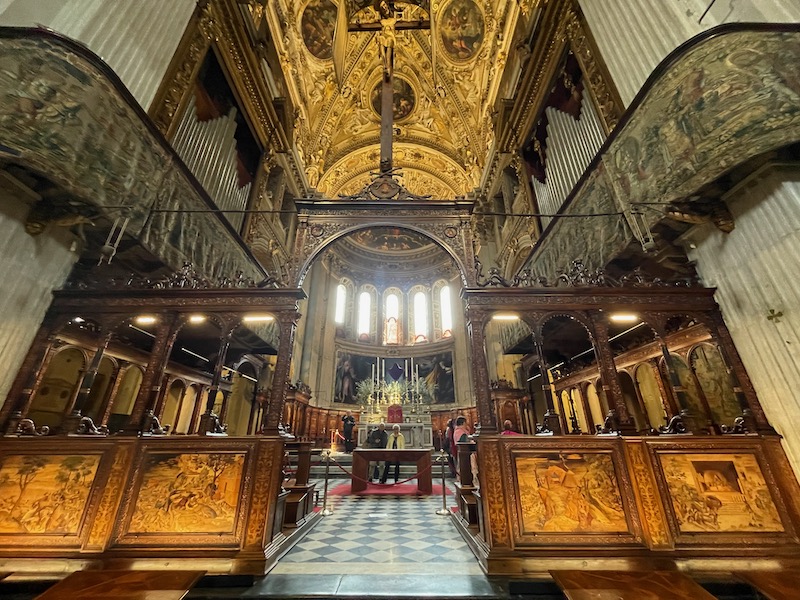
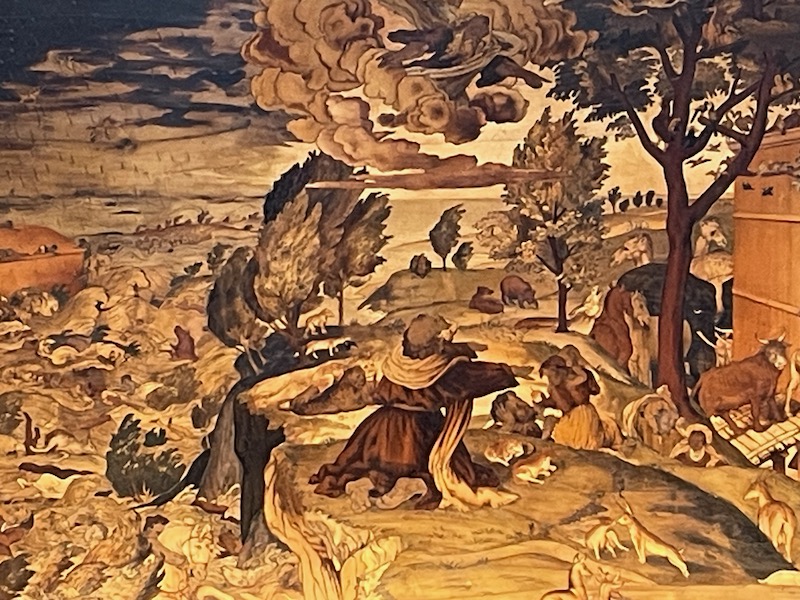
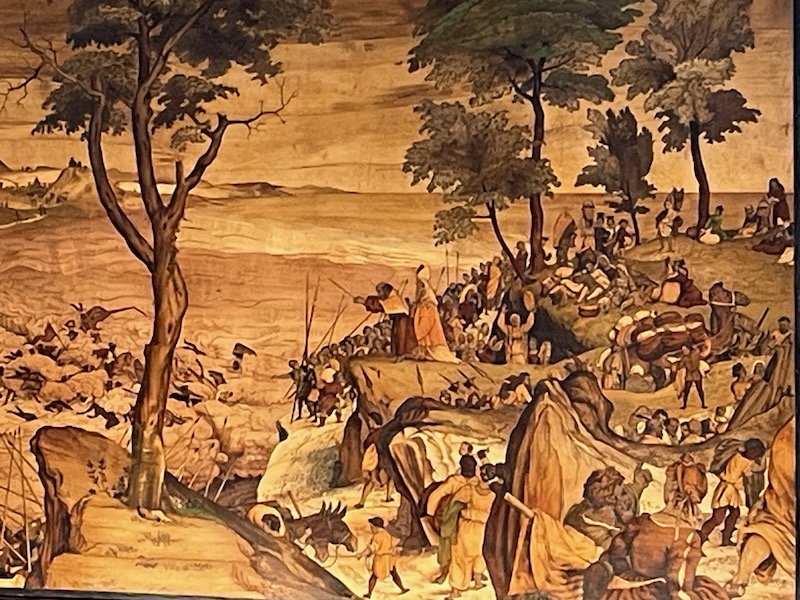
This is the 1704 Fantoni Confessional, the work of an 18th-century cabinet-maker and sculptor named Andrea Fantoni. It is carved from several different types of wood to give different elements of color and detail. There are sculptures and high reliefs all over it with the statues and carved scenes having symbolic meanings around the sacrament of confession.
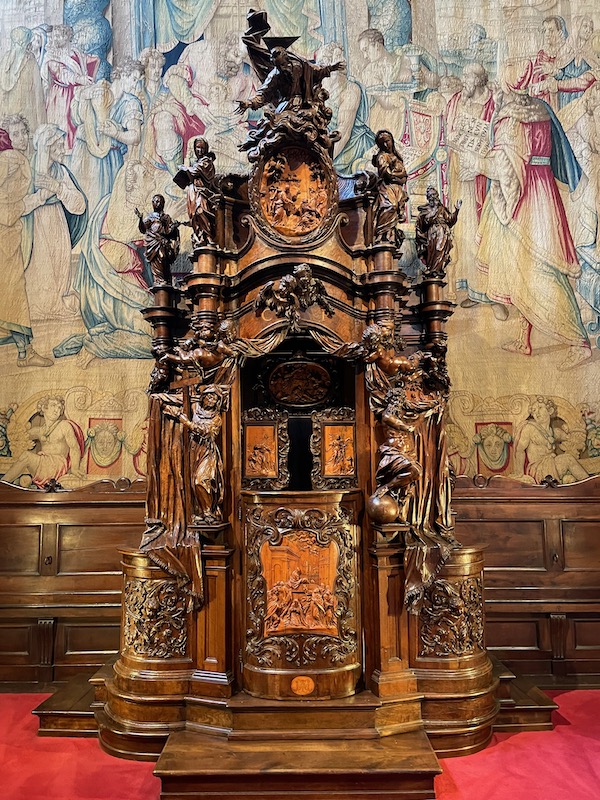
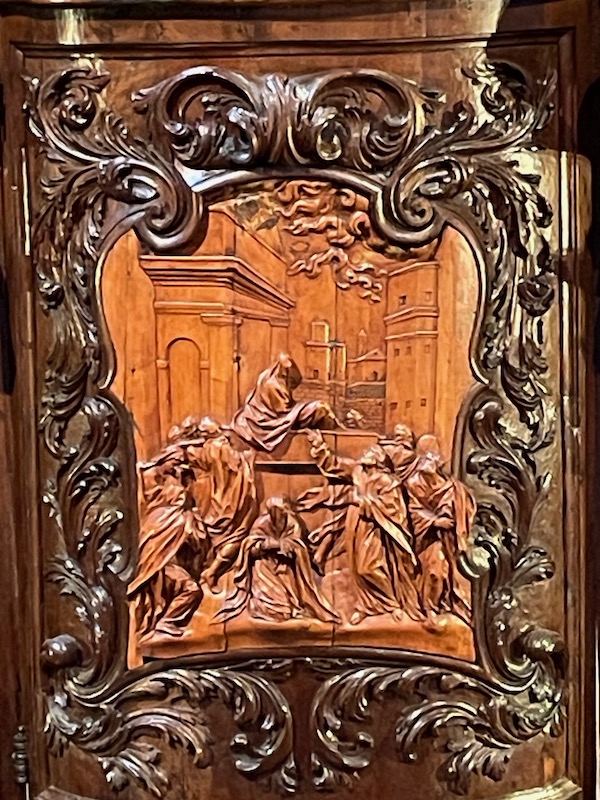
More inlays, these are smaller sized ones that are in each choir chair, each with a different scene, this one being Noah's Drunkenness (done in 1524).
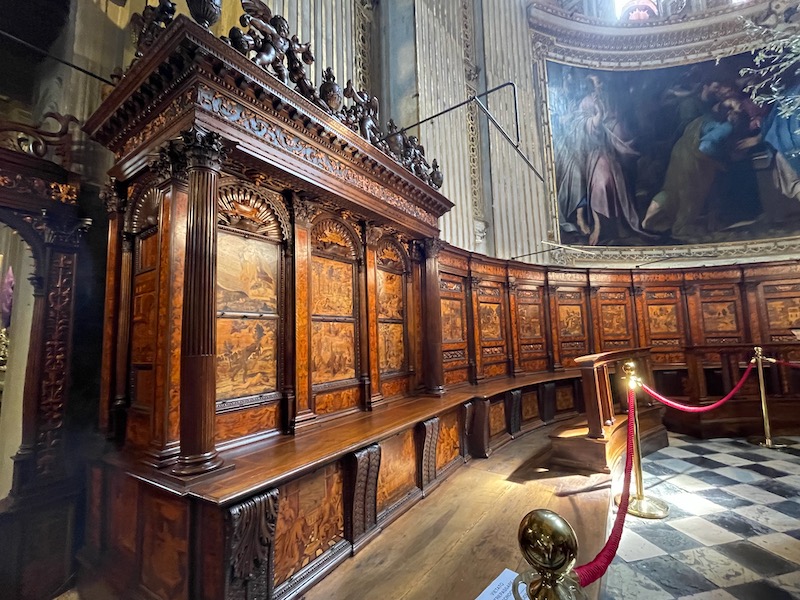
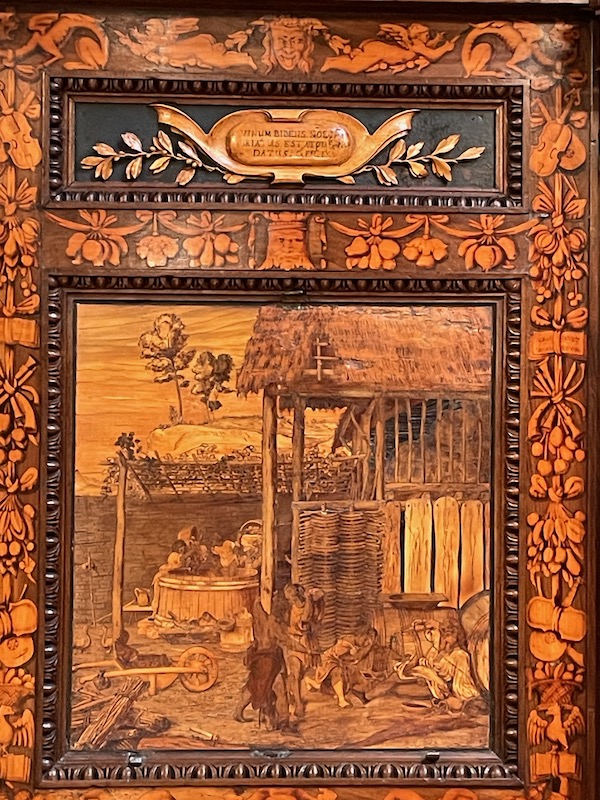
In the right transept are 14th-century frescoes with Stories of Saint Egidio and The Last Supper. The Last Supper has quite a bit of detail, showing the table set on a white tablecloth, showing Eucharistic symbolism with bread, cherries, jugs of water and wine and fish, symbol of the first Christians. The depiction of Saint Eligio presents a precision and naturalness of the act of shoeing a horse, but also of the working environment showing his daily life.
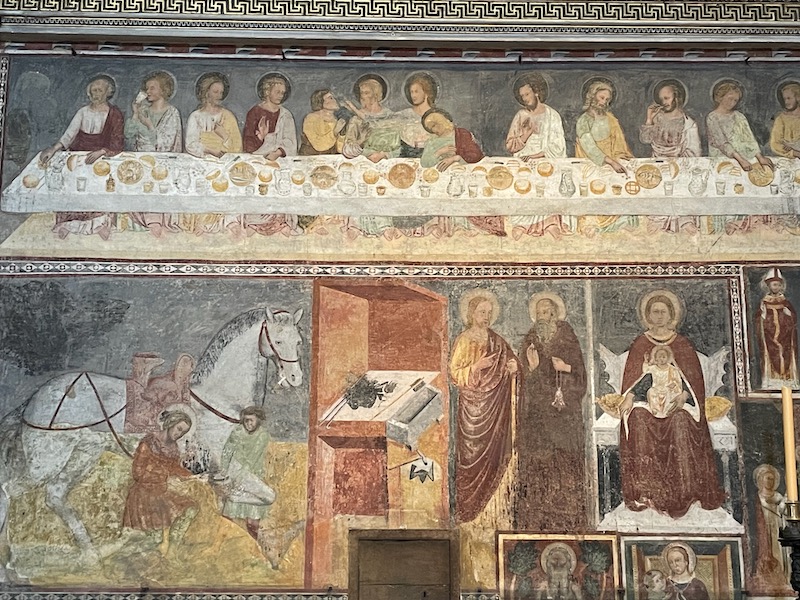
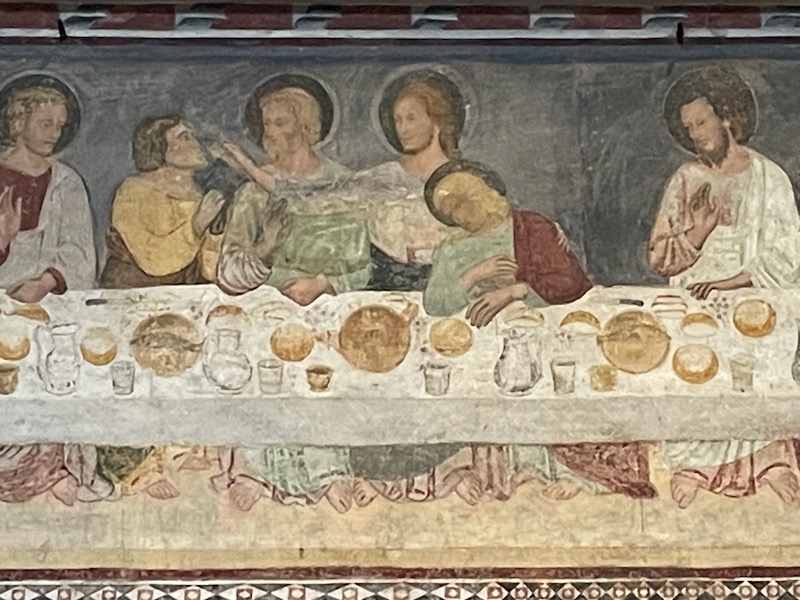
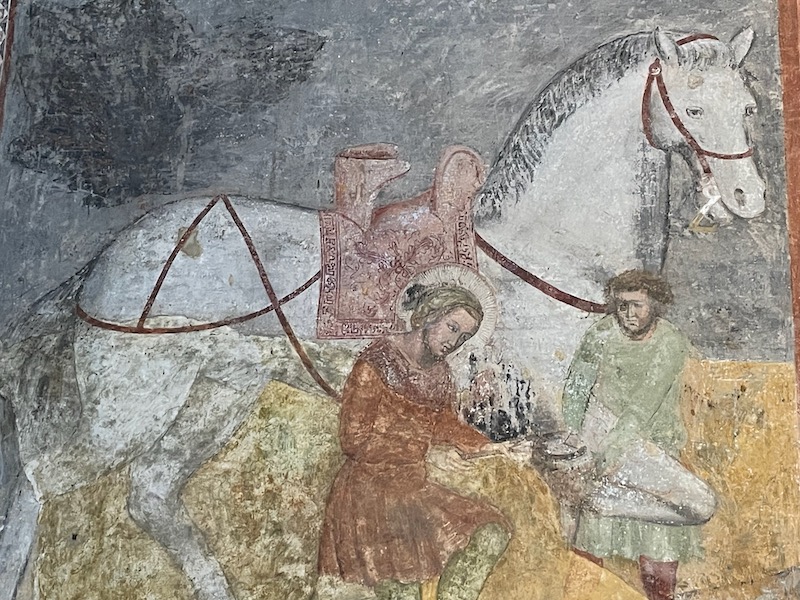
Colleoni Chapel (on the right-side of the Basilica) was commissioned in 1472 by the Commander General of the Venetian Republic as a mausoleum for him and his family. It is the finest example of Renaissance architecture in Bergamo. The outside is pretty impressive, but the inside was even more impressive, with an equestrian statue of Colleoni in gilded wood from 1510 and frescoes dating from 1733. There was a sign that said no pictures at all, which I followed, but if you are interested, there are some pictures of the interior on the Wikipedia page of the chapel. One interesting note ... in a bit of the documentation, this type of "rose window" is called a "Wheel of Fortune" window, due to the columns that split it into triangles.
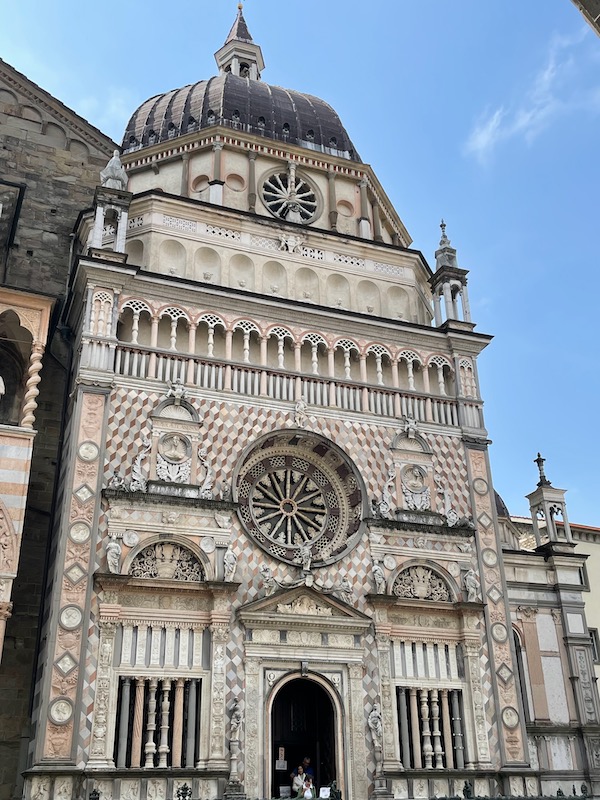
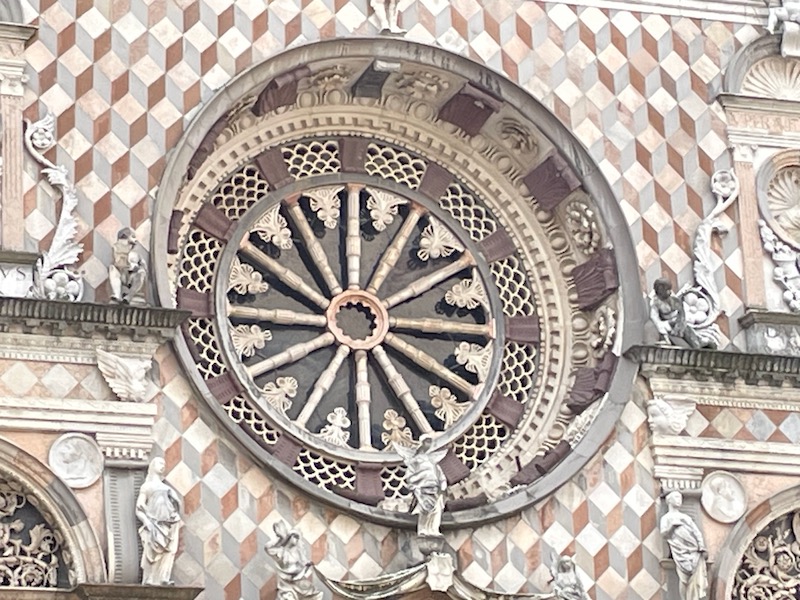
Parts of the Baptistry date back to the 1340 but the history is a bit odd. Originally, it was in a different church, then moved into the Basilica against the back wall, then into one of the chapels, and then in the Cathedral. In 1897, they decided to create a separate Baptistry building in the Piazza del Duomo and this one was created, in the typical octagonal form with a neo-Gothic style. On the roof are 8 statues representing each of the Christian virtues: Faith, Hope, Charity, Fortitude, Justice, Prudence, Temperance, and Patience. It was closed during the time we were there, so unfortunately, no pictures on the inside.
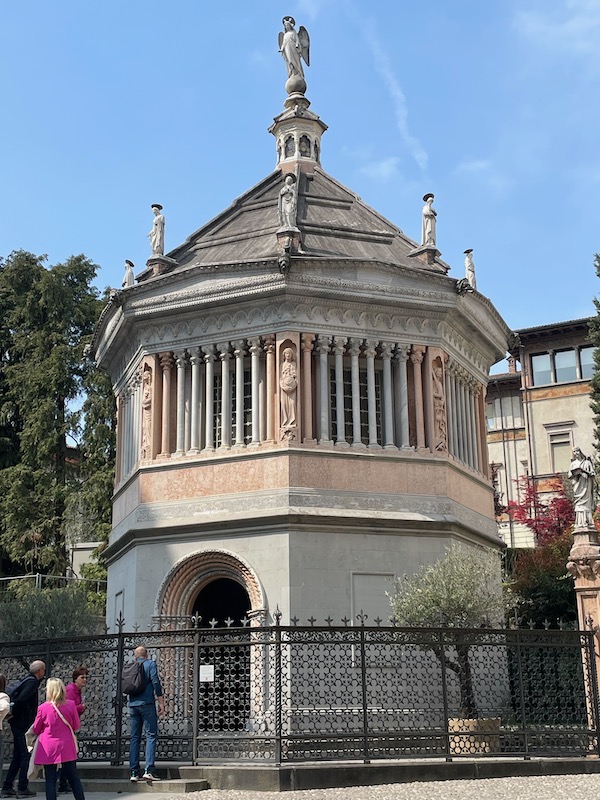
Opposite the Baptistry is the Cathedral of Sant'Alessandro, dedicated to Saint Alexander, the patron saint of Bergamo. It was built starting in 1459 but the work was abandoned in 1513. Work restarted in 1688 and was mostly finished in 1693. Additional changes were done and a new façade in white Botticino marble was added in 1889.
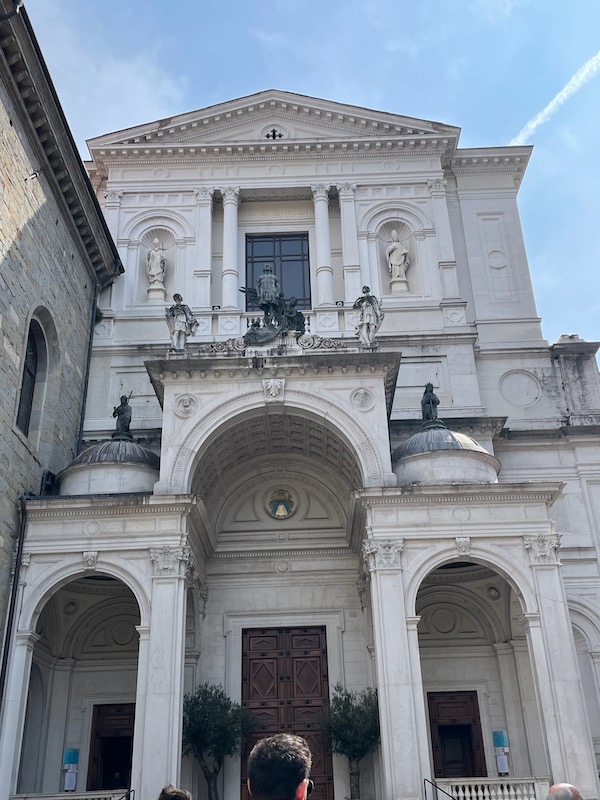
The interior has a Latin cross plan, with a single nave, 3 side chapels on each side, and a barrel vault with lunettes. While definitely not as ornate as the Basilica, it is still highly decorated but in a more harmonious way. The various altarpieces seem to have a Baroque style to them.
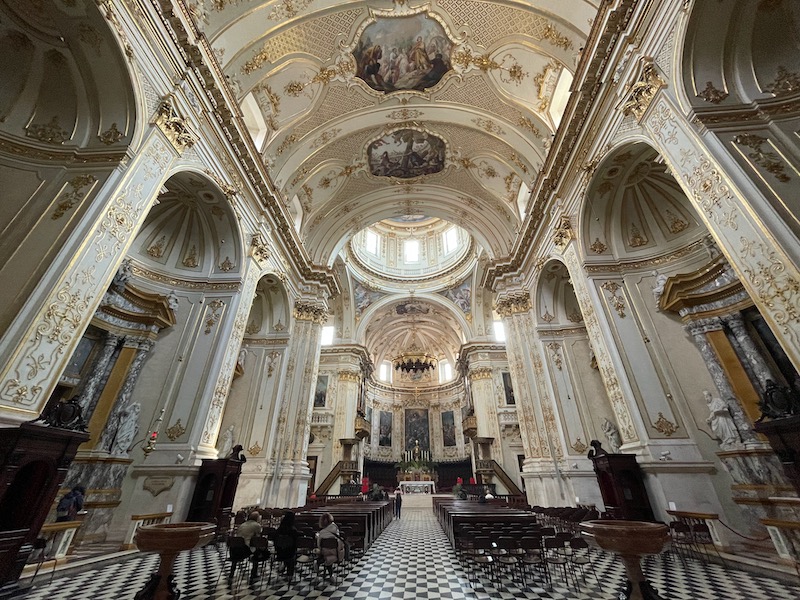
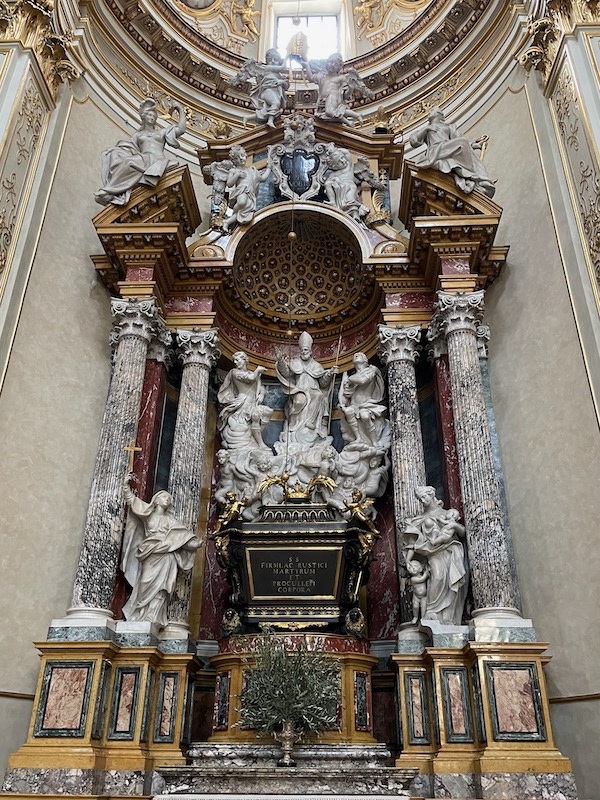
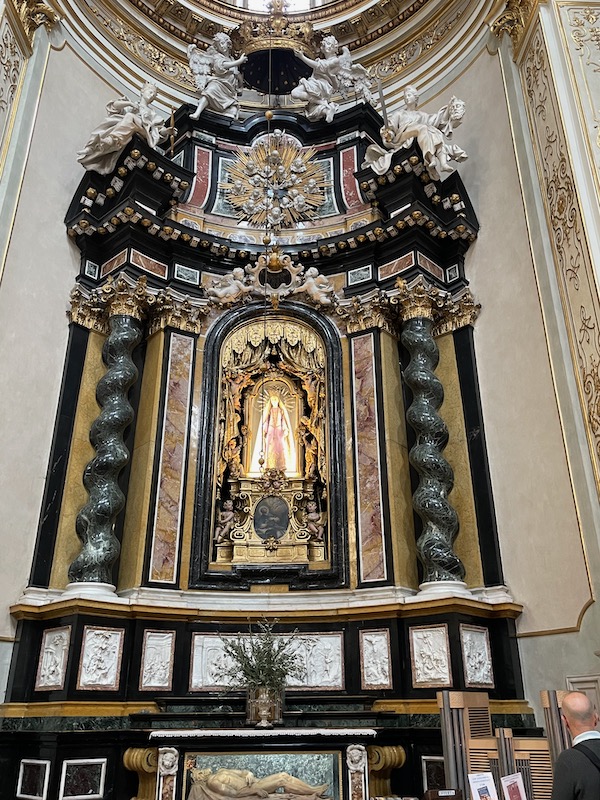
The semi-circular apse contains 7 large paintings dating from the 1690s to 1745. The main altar has a marble table with a 17th-century silver decorative panel in the front. The silver urn contains the remains of the martyr Saint Alexander.
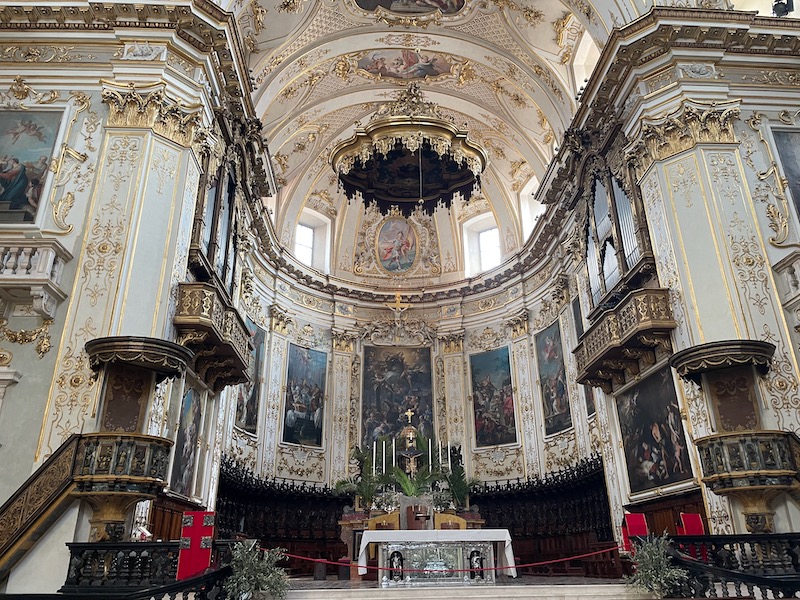
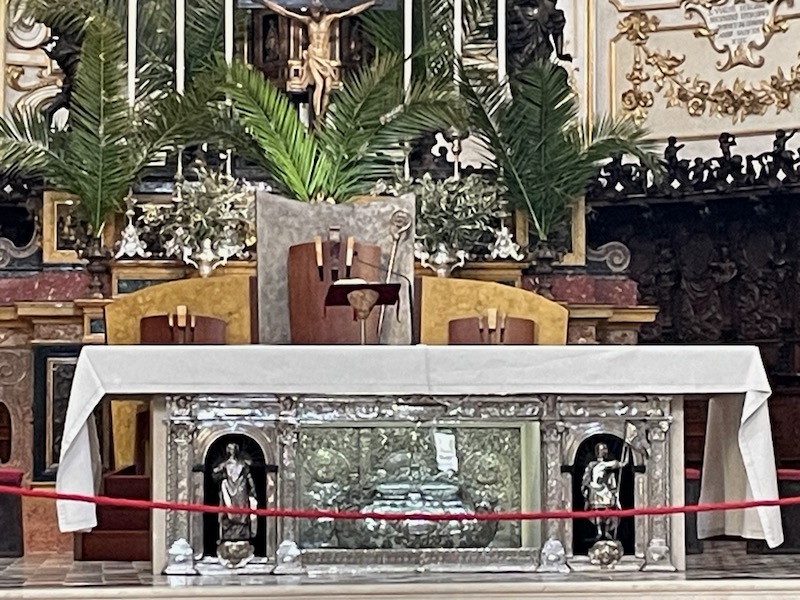
Here are the frescoes in the dome, done by Francesco Coghetti, showing the great Triumph of Saint Alexander.
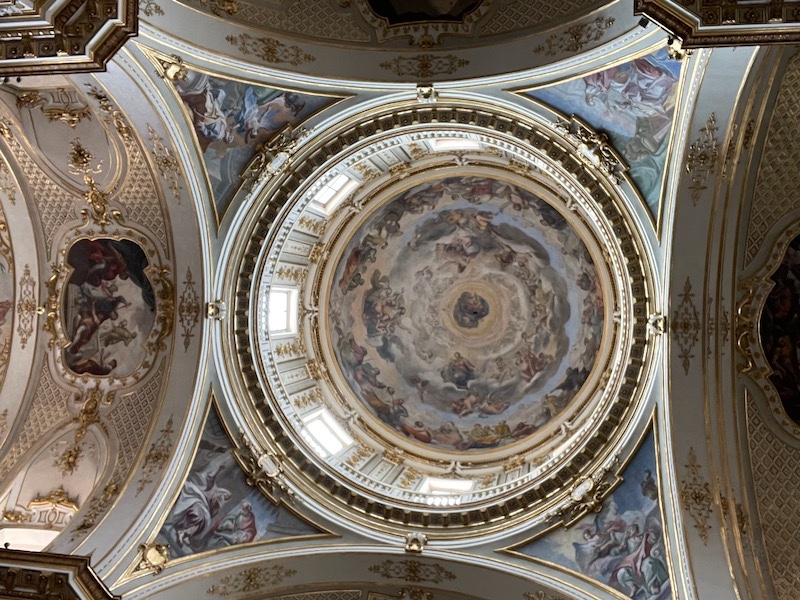
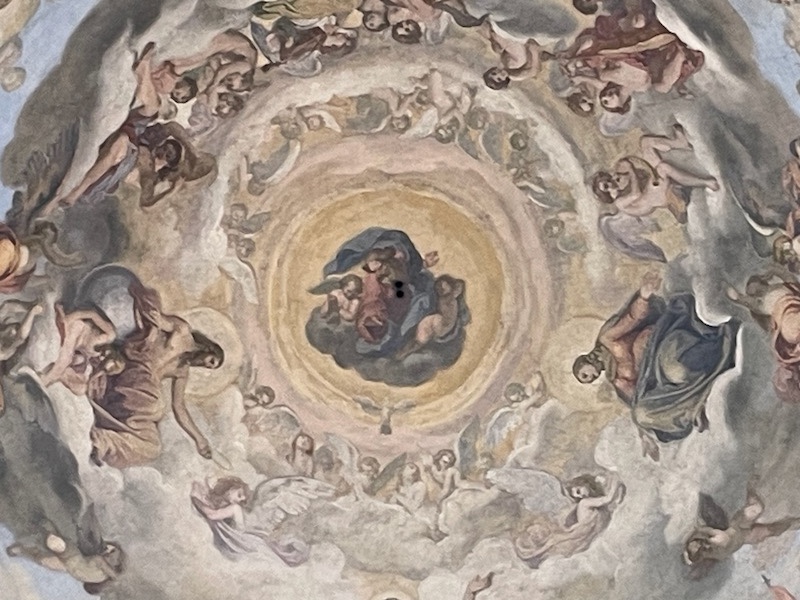
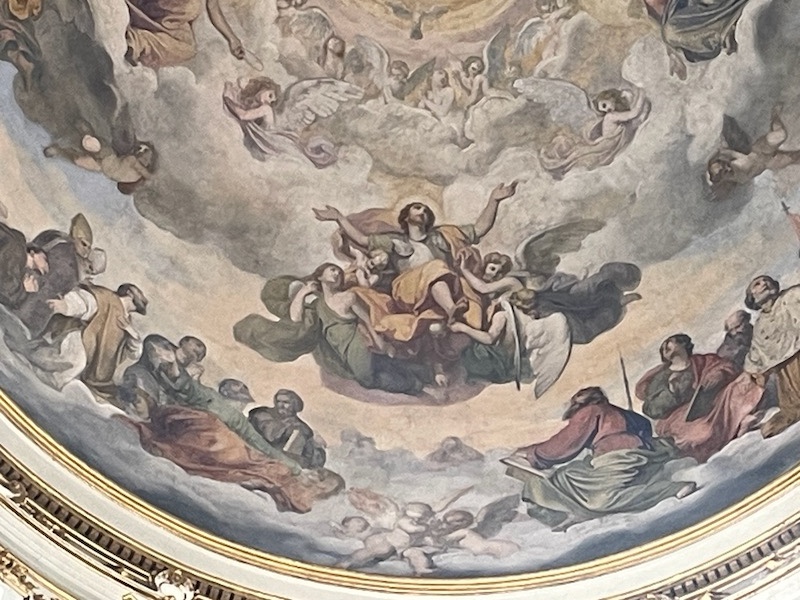
The chapel of the Crucifix was built in the 19th century, dedicated to the Crucifix because the altar has the crucifix from the Church of Santa Maria di Rosate, considered miraculous and placed here in 1810 when the other church was closed. The fresco above depicts the Descent from the Cross.
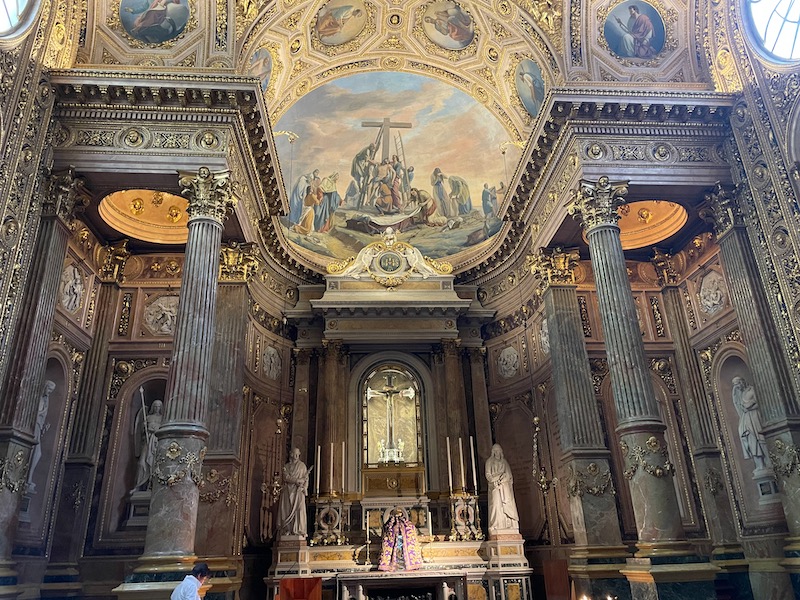
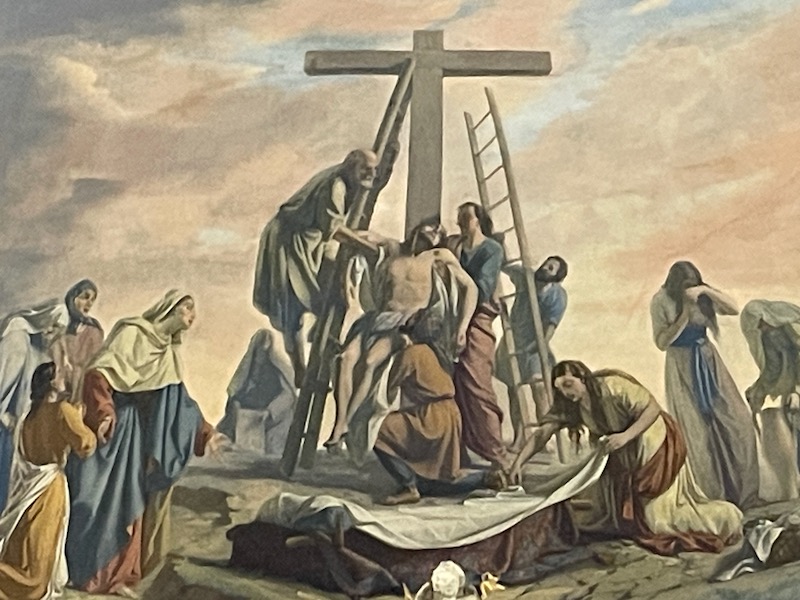
Venetian Walls were constructed in the 16th century when Bergamo was under the rule of the Venetian Republic. The walls were meant to keep invaders out and show off a bit of Venetian might.
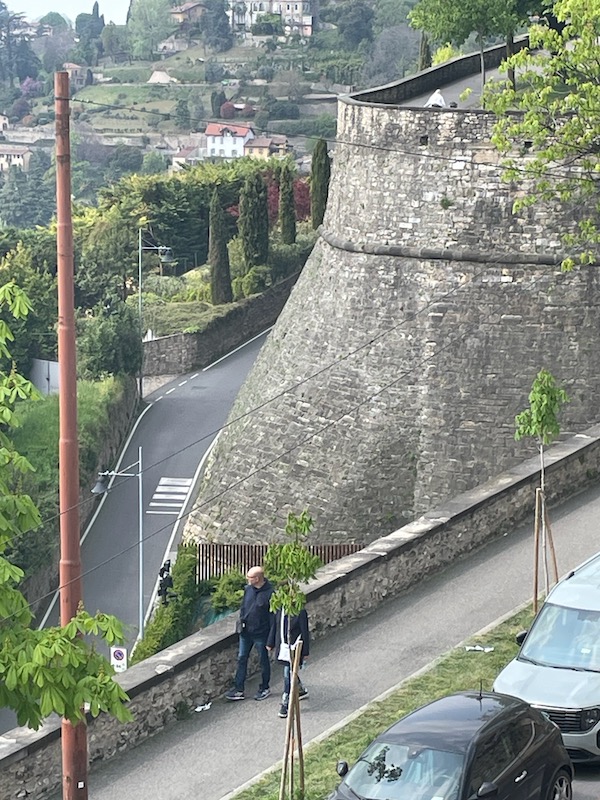
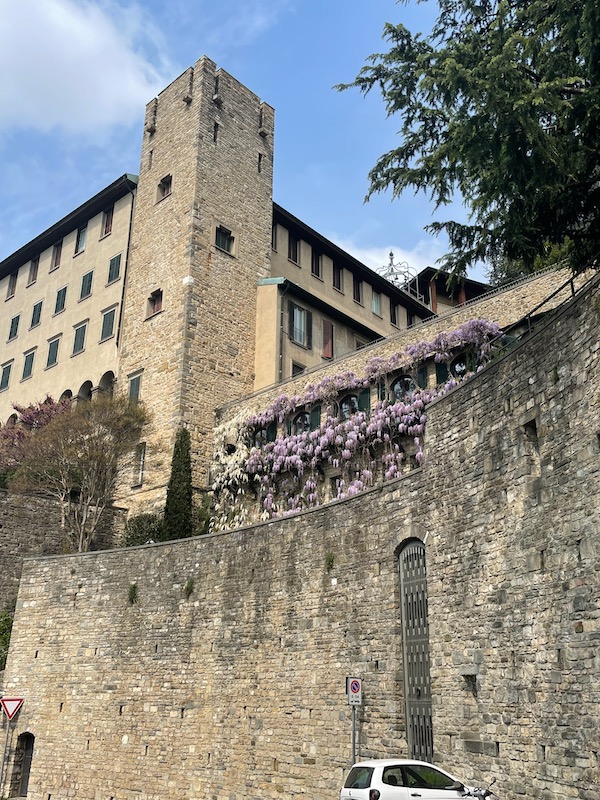
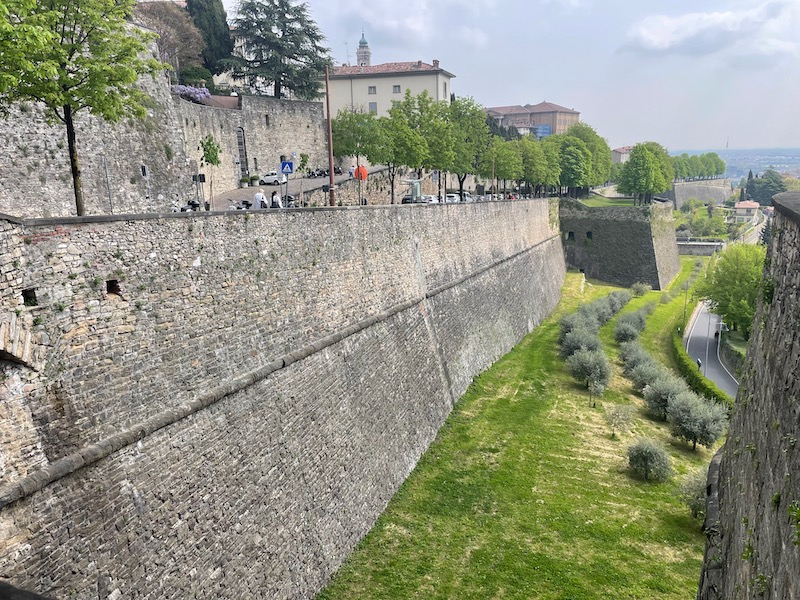
San Vigilio Castle was the last bastion of the city’s defenses: if San Vigilio fell, so did Bergamo. Which is why over the centuries, a labyrinth of tunnels, secret passages, and escape routes were dug out beneath the castle’s walls to be used in the event of a siege. Of the original castle, built in 1482, there are 4 towers, the battlements, the walkways, and the embrasures are still visible today. We took the funicular up to the top and then walked back down.
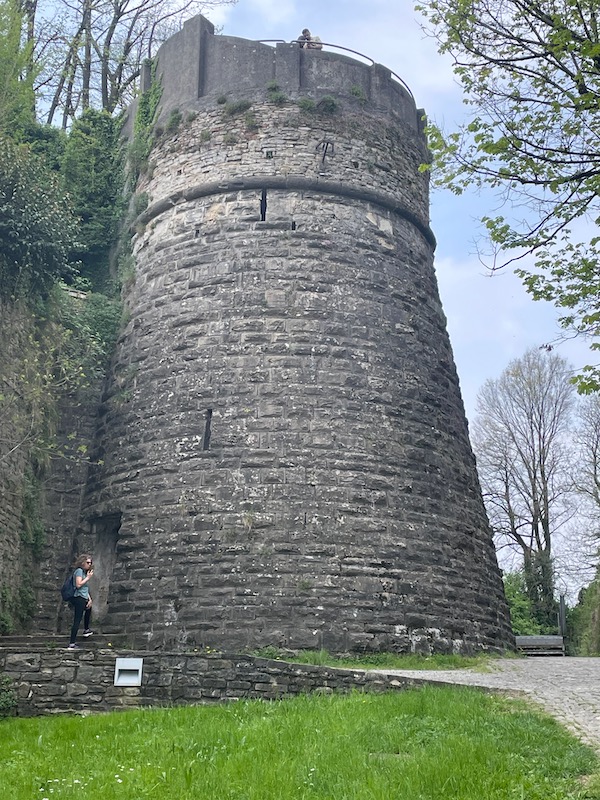
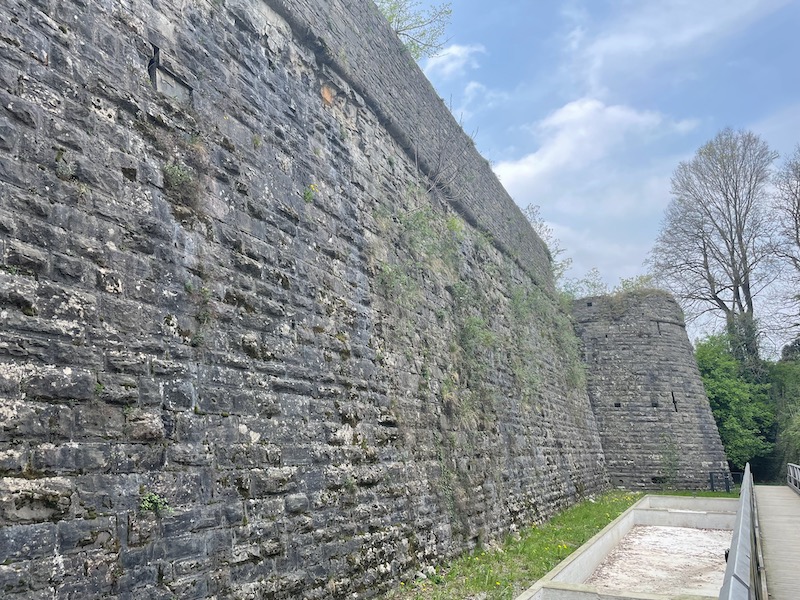
A few views from the Castello at the very top, looking down on the Upper Town (with the Duomo and Basilica) and the Lower Town.
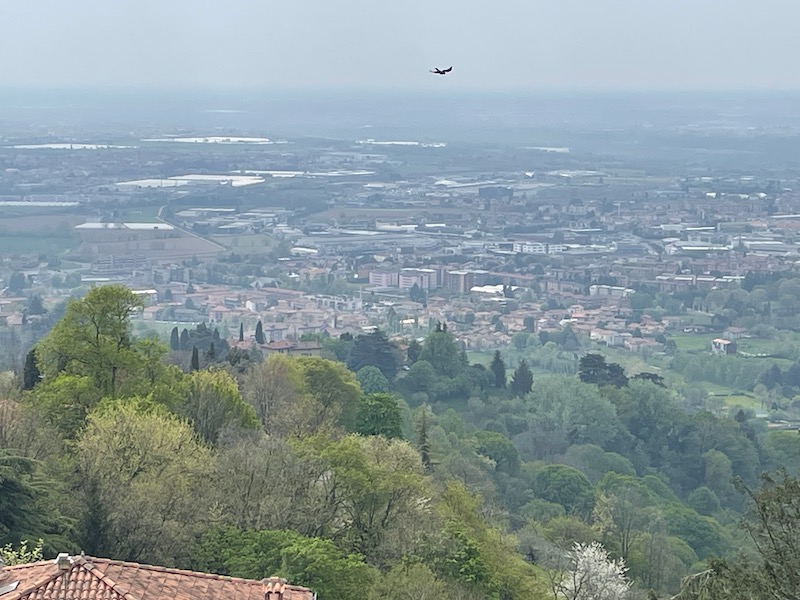
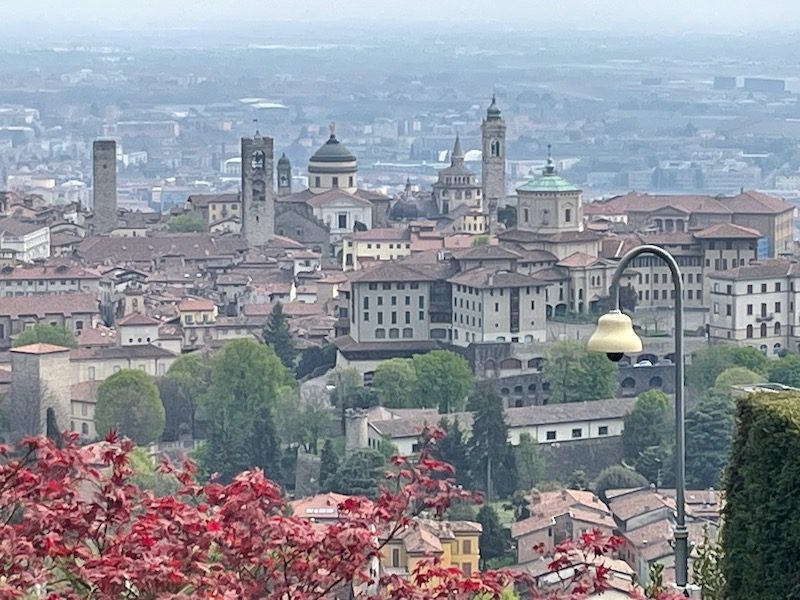
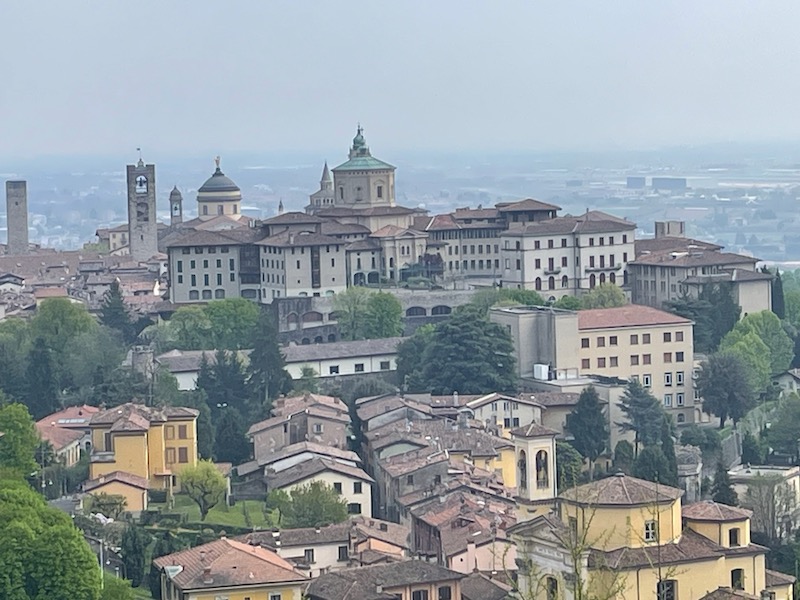
I initially thought this was climbers going up the Venetian walls ... but in fact ... they are workers who are cleaning off the plants that are growing on the side of the wall ... compare the "clean" left-hand side of the wall to the right-hand side with the green plants growing.
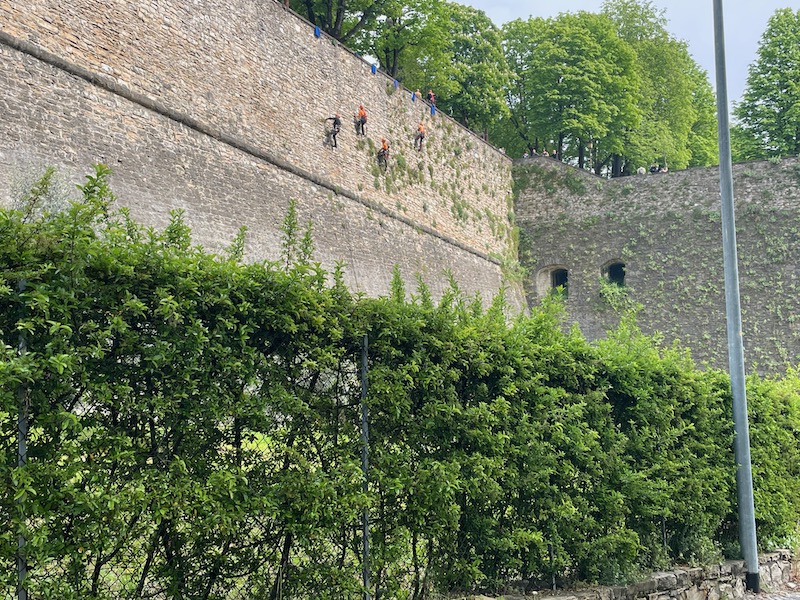
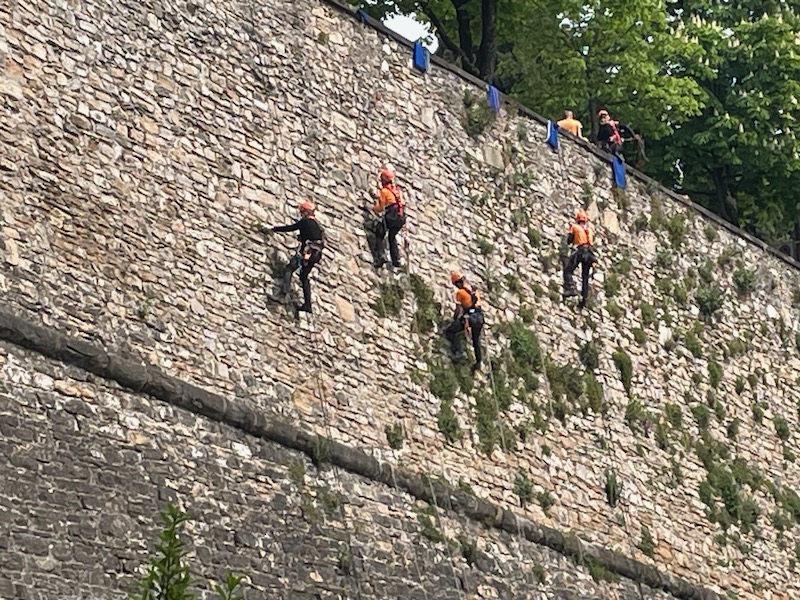
The Torre dei caduti, down in the modern lower-town, is a memorial tower in honor of soldiers from World War I. It was started in 1922, just after the war and inaugurated in 1924.
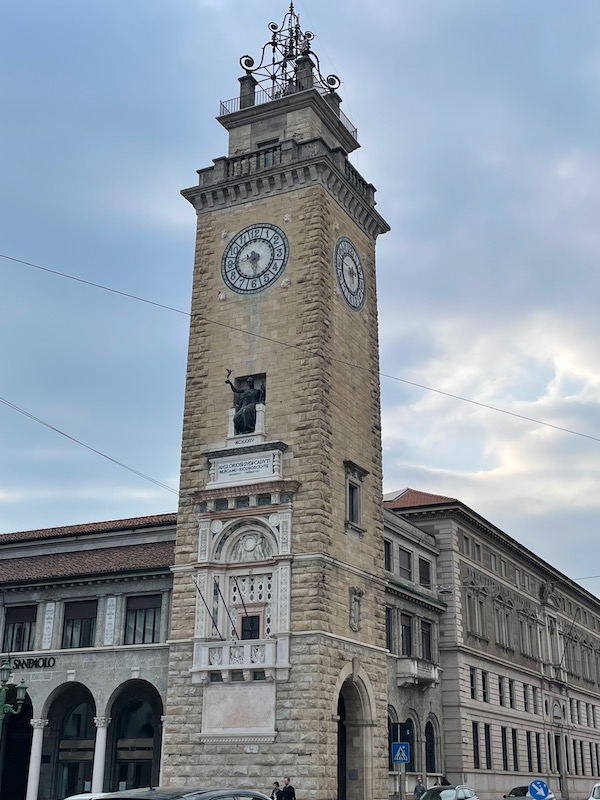
I took just a couple pictures as we were coming back from dinner in the Upper Town .. the first is the same gate that we saw earlier, but lit up, and then the massive Venetian walls.
